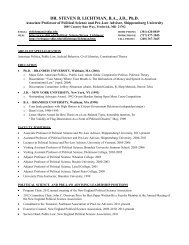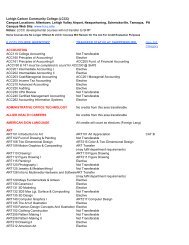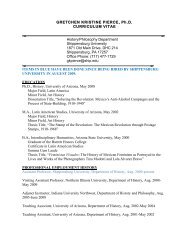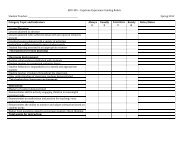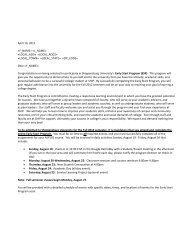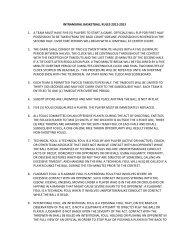Complete Issue - Shippensburg University
Complete Issue - Shippensburg University
Complete Issue - Shippensburg University
- No tags were found...
You also want an ePaper? Increase the reach of your titles
YUMPU automatically turns print PDFs into web optimized ePapers that Google loves.
60 PROTEUS: A Journal of IdeasThreat of substitution corresponds to customershaving the ability of substituting one product foranother. Pertaining to water supply and distribution,this signifies governmental entities substituting a utilityplant for another system, such as individual wellsserving residential enclaves. Another substitution callsfor customers to implement their own resources todevelop water systems. Because these substitutions arepossible and do occur, but do not characterize a majorshift in the marketplace, this threat warrants a mediumassessment.Threat of new entry signifies new competitorscoming into the market. Although many competitorsexist, long-term contracts characterize the nature of theindustry. This force assesses low because of the costlybarriers to enter a market. The feasibility of establishinga second water utility in a given region determines thisassessment, not only because of the cost for duplicateinfrastructure but also because rights and franchises fordistributing water are exclusive.Competitive rivalry assessment results from thecombination of the first four forces. Evaluating thecontributive forces, the competitive rivalry in the watersupply system is low to medium, warranting continuedevaluation. If a significant amount of new watersystem development occurs in the twenty-first centuryreducing the growth potential, this may change (Porter1985).Geographical influences. Because of the urbanizationresulting from industrialization occurring first inEurope, developing water supply infrastructure becameparamount. Imperial decree set the French evolution inprocess, creating a favored industry.Approximately one billion people currently donot have adequate water supply. The areas affectedepitomize the geographic areas where future growthwill occur (Anonymous 2004) and the major companiesare poised to capture these markets. In many countries,controversy exists over true water privatization, wherewater companies actually own the systems they operate.Surprisingly, true water privatization is less commonin the United States than in other countries andcontinents (Bate 2004).The global competitive nature of the water supplysystem evolved over centuries, and industrializationexpedited its growth. Economic development can onlyoccur after the construction of primary infrastructure.Water supply services exist on a scale ranging frompublic utilities constructed, owned, and operated bygovernmental entities, to a public-private partnershipbetween the governmental entity and firms such asVeolia, to completely privatized operations. The watersupply design, build, and operate industry will continuegrowing, doubling in the next ten years. However, thisgrowth occurs in geographic areas that now representthe smallest segment of current industry operations.Through mergers and acquisitions, the total numberof suppliers will diminish by 75 percent in the nextdecade. Analyzing competitive rivalry utilizing Porter’sfive-forces model reveals that competitive rivalry existsin a medium range as most of the contributing forceslie in that range.Although over 90 percent of Veolia’s currentbusiness takes place in Europe and the United States,the locations accounting for the remaining 10 percentrepresent the majority of future growth. Its currentrevenue base exists in industrialized nations; futurerevenue growth can only come from developingcountries (Veolia 2006). Veolia is a global leader in thisindustry.The Competitive Structure of Design, Build andOperate Water Supply Systems in ChinaDBO in China. The People’s Republic of China,governed as a communist state since its revolutionin the 1940s, has allowed free-market transactionssince 1978. Since then the resultant growth in theireconomy averages approximately 10 percent per year,almost three times the rate of major western nations.This growth shows no sign of abating and at timeshas reached 12 percent. China’s growth continues todirect infrastructure development. Economic growthrepresents a primary focus for the government,expecting their blend of communism and capitalism tosave them from the fate of the former Soviet Union.For continual economic development, infrastructureconstruction must occur first, and water supply systemsrepresent the primary component of that infrastructure(Chao & Chuang-lin 2007).The central government invites companies tonegotiate the nature of their operations in China. Thisacts as tacit approval for local and regional governmentsto utilize these companies (Tan, Li, and Xia 2007).Operating in China since 1997, Veolia became thepremier water supply systems provider in that country,investing over one billion dollars as of 2004. Otherwater supply system companies operating in China areBerlin Water, Thames Water, and the other Frenchcompany, Suez Lyonnaise (Zin 2004).Porter’s diamond model. In his book, The CompetitiveAdvantage of Nations, Porter (1990) defines a modelthat provides reasoning why some companies succeedin the global competitive environment and othersdo not. Attributing success to characteristics in thehome country of the organization, Porter defines thesefeatures and relates them in four points of a diamond,with bidirectional flows moving to and from each point.The four points are:• Factor conditions are resources and inputsclassically identified by economists as the factorsof production such as skilled labor, developedinfrastructure, and technological advances.These conditions aid in developing a competitiveadvantage for various industry segments. Porterdefined several subcategories and demonstratedthese initial advantages constitute building blocks



